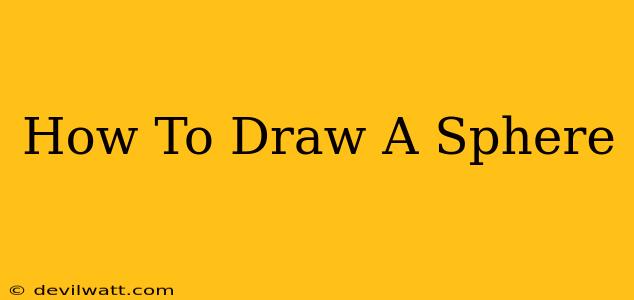Drawing a perfect sphere can seem daunting, but with the right techniques and a little practice, you can master this fundamental form. This guide breaks down the process into easy-to-follow steps, catering to both beginners and those looking to refine their skills. Whether you're aiming for photorealism or a more stylized approach, understanding the underlying principles is key. Let's dive in!
Understanding the Basics of Sphere Drawing
Before we begin, it's important to understand what makes a sphere look three-dimensional on a two-dimensional surface. A sphere is a three-dimensional object with a perfectly round surface. To represent this on paper, we rely on shading and perspective to create the illusion of depth and form.
Key Concepts:
- Light Source: Identify your light source. This dictates where highlights and shadows will fall.
- Highlights: The brightest areas of the sphere, reflecting the light source directly.
- Midtones: The areas between the highlights and shadows. These gradually transition in value.
- Shadows: The darkest areas, indicating the parts of the sphere furthest from the light source. This includes the core shadow (the darkest part) and the cast shadow (the shadow projected onto the surface).
- Reflected Light: A subtle lighter area within the shadow, reflecting light from the surrounding environment.
Step-by-Step Guide to Drawing a Sphere
Let's now walk through the process of drawing a sphere, step-by-step:
Step 1: Start with a Circle
Begin by drawing a light circle. Don't worry about making it perfect; it's just a guide. Think of this as your sphere's underlying structure.
Step 2: Determine Your Light Source
Decide where your light source is coming from. Let's say it's from the upper left.
Step 3: Identify Highlights and Core Shadows
Based on your light source, mark the highlight (the brightest point) and the core shadow (the darkest point) on your circle. The highlight will be directly opposite the core shadow.
Step 4: Gradual Shading
This is where the magic happens. Using a smooth, gradual approach, start shading the areas around the core shadow, gradually lightening the tone as you move towards the highlight. Don't use harsh lines; blend your tones seamlessly. Remember to consider the midtones – the gradual transition between light and shadow.
Step 5: Refined Shading and Detail
Now, add more subtle details. Consider adding a reflected light area within the shadow to create a more realistic effect. Pay attention to the edges of the sphere; these will likely have a slightly softer, less defined transition than the rest of the shading. Practice using different shading techniques like hatching, cross-hatching, or blending to achieve the desired effect.
Step 6: Adding a Cast Shadow
Complete your drawing by adding a cast shadow. This is the shadow the sphere projects onto the surface beneath it. It should be darkest closest to the sphere and gradually fade out as it extends away.
Tips and Tricks for Drawing Perfect Spheres
- Practice Regularly: The more you practice, the better you'll become at understanding light and shadow.
- Use Different Shading Techniques: Experiment with hatching, cross-hatching, and blending to find your preferred method.
- Observe Real-Life Spheres: Pay close attention to how light interacts with spherical objects in your everyday life.
- Reference Images: Using reference images can be incredibly helpful, especially when starting out.
- Vary Your Light Sources: Try different light source positions to challenge yourself and improve your understanding of shadow placement.
Beyond the Basics: Exploring Different Styles
Once you’ve mastered the fundamentals, you can experiment with different artistic styles. You can create a more stylized sphere with less realistic shading, or aim for photorealism by paying close attention to minute details and subtle variations in light and shadow. The possibilities are endless!
By following these steps and practicing regularly, you'll be well on your way to drawing stunningly realistic and expressive spheres. Remember, patience and practice are key. So grab your pencils, and happy drawing!

